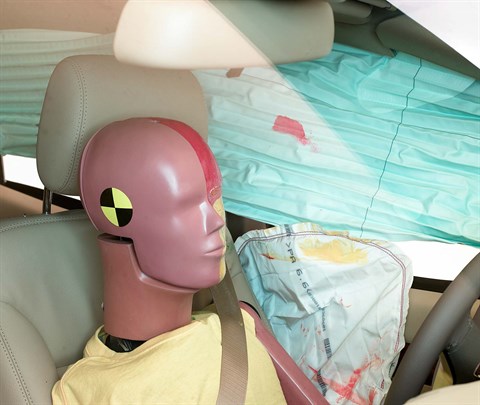Moderate overlap front: original test
Rating applies to 2006-12 models
Tested vehicle: 2007 Mercedes-Benz R 500 4-door 4wd
The Mercedes-Benz R-Class was introduced in the 2006 model year and restyled for the 2011 model year. Frontal ratings are assigned by the Institute based on a test conducted by Mercedes-Benz.
| Evaluation criteria | Rating |
|---|---|
| Overall evaluation | |
| Structure and safety cage | |
| Driver injury measures | |
| Head/neck | |
| Chest | |
| Leg/foot, left | |
| Leg/foot, right | |
| Driver restraints and dummy kinematics | |
Side: original test
Rating applies to 2009-12 models built after September 2008
Tested vehicle: 2009 Mercedes-Benz R 350 4-door 4wd with standard head curtain airbags for all three rows of seats and standard front and 2nd row seat-mounted torso airbags
The Mercedes-Benz R-Class was introduced in the 2006 model year. Beginning with 2007 models, side torso airbags were made standard for second row seat occupants (they were optional in 2006 models). The vehicle was restyled for the 2011 model year.
Two previous tests of a 2008 R-Class were conducted, and measures from the driver dummies in these tests, taken together, indicated that rib fractures would be possible. In response, Mercedes-Benz modified the front door trim panels and seat belts beginning with 2009 models manufactured after September 2008 (note: information about when a specific vehicle was manufactured is on the certification label typically affixed to the car on or near the driver door). The tested vehicle was manufactured after the modifications had been made, and forces on the driver dummy's ribs were significantly reduced.
The 2009 and later models built after September 2008 are therefore rated separately, except that the structure rating is based on the two previous tests plus the latest test.
| Evaluation criteria | Rating |
|---|---|
| Overall evaluation | |
| Structure and safety cage | |
| Driver injury measures | |
| Head/neck | |
| Torso | |
| Pelvis/leg | |
| Driver head protection | |
| Rear passenger injury measures | |
| Head/neck | |
| Torso | |
| Pelvis/leg | |
| Rear passenger head protection | |

View of the vehicle and barrier just after the crash test.

View of the vehicle after the crash with doors removed, showing the side airbags and damage to the occupant compartment.

Smeared greasepaint shows where the driver dummy's head was protected from being hit by hard structures by the side airbags.

Smeared greasepaint shows where the rear passenger dummy’s head was protected by the side airbags.
Head restraints & seats
Seat type: Seats without auto-adjust head restraints AHR
| Overall evaluation | |
|---|---|
| Dynamic rating | |
| Seat/head restraint geometry |
About the head restraint & seat test
Currently, IIHS tests apply only to front seats.
